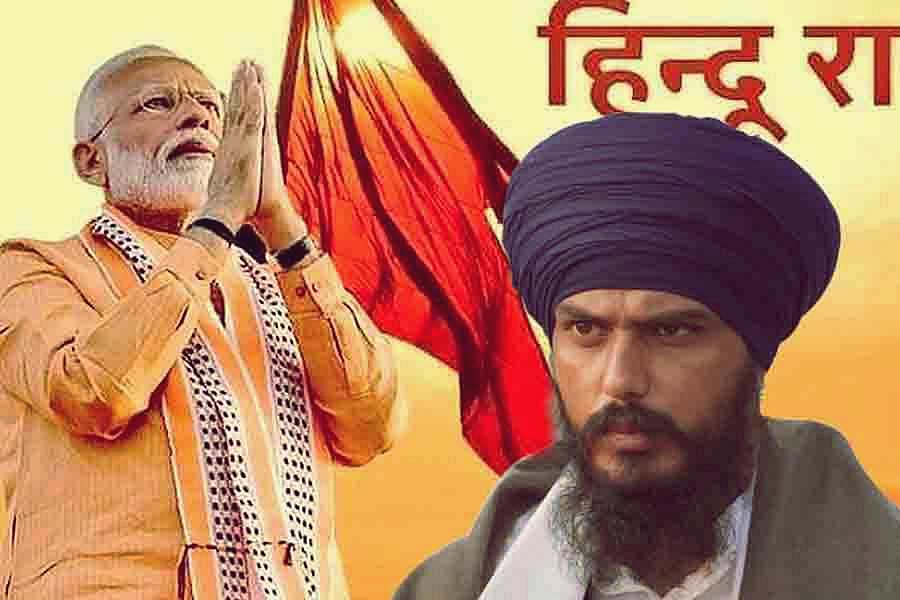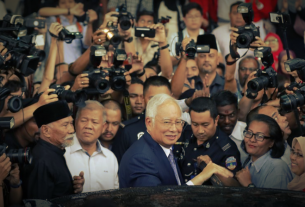Tue 28 March 2023:
The unprecedented scale of action on Amritpal, who otherwise could have been arrested without either much noise or spectacle, appears to be an attempt to demoralise civil society by creating a ‘fear psychosis’, says historian and expert, Prof. Harjeshwar Singh.
Chandigarh: A sense of uncertainty continues in Punjab as the police chase of Sikh hardliner and pro-Khalistan preacher Amritpal Singh entered its seventh day on March 25.
What has made the matter even more complex is that the search is no longer confined to Punjab.
As per the latest confirmation from Punjab police, he has managed to cross over to other states after slipping out of Punjab. Uttarakhand, as per media reports, is on high alert over his possible presence there.
PUNJAB POLICE DENIES ANY ‘MISHANDLING’ AS AMRITPAL SINGH STILL AT LARGE, INTERNET SHUTDOWN EXTENDED
Ever since the crackdown on him began, on March 18, security agencies have been claiming that Amritpal was using all means, including violent means, for a separate Sikh nation called ‘Khalistan’.
The Wire spoke with Harjeshwar Singh, who teaches history at Chandigarh’s Sri Guru Gobind Singh College and is also a keen observer of religio-political and social dynamics of Punjab, to try and decode what Amritpal and the consequent drama around him means.
Do you believe Amritpal’s agenda for ‘Khalistan’ had gained momentum in Punjab and that made him a potential threat?
To say that he [Amritpal] was not gaining ground is not true. He was being heard and seen. He too became a centre of public debate, more so after his illegal act of storming a police station in Ajnala near Amritsar. Many of his controversial statements or actions even led to mass protest in the state, especially among Christians.
But was he such a big threat to warrant the unprecedented police action as witnessed in the past few days?
Amritpal was, no doubt, violating public order and should have definitely been arrested. But I believe he was not such a big threat, which needed a police operation of such a scale and size as seen in Punjab over the last few days. [His crackdown operation included] so many arrests, suspension of Twitter accounts including those of journalists, which have become a new normal in Punjab, the invoking of section 144 [of the Criminal Procedure Code] and then shutting down internet services for days. All this was too much, and the funny part is that all are under arrest except him!
This raises a lot of questions on why it was done the way it was done. Even today, there is not much support for Amritpal on the ground. I am travelling in Punjab and no one is talking much about him except that he deserved police action. But there was no logic behind such a huge spectacle, including the internet being shut down for days. He was no Bhindranwale.
PUNJAB POLICE ‘ARRESTS’ AMRITPAL SINGH, 6 SUPPORTERS; INTERNET SUSPENDED ACROSS STATE
So what could be the potential reason for this hype?
Ever since the farmers’ protest, Punjabi society has been witnessing a churning where civil society is getting more assertive and feeling empowered. The successful protests against the proposed industrial park in Mattewara or closure of the liquor factory in Zira are examples of how people in Punjab are fighting for their rights on different issues.
Then at the same time, there has been a sense of restlessness and anger reflected in public protests after the death of Sidhu Moosewala and the rise of gangsters. Police action against Amritpal, therefore, came at the time of Moosewala’s first death anniversary (March 19), when the current dispensation was being asked serious questions about the gangsters accused of killing Moosewala.
Overall, the unprecedented scale of action on Amritpal, who otherwise could have been arrested without much noise or spectacle, appeared to be an attempt to demoralise the civil society by creating a “fear psychosis” and serving as a possible reminder of the days of the militancy in the 1980s.
“CANADA CLOSELY FOLLOWING DEVELOPMENTS IN PUNJAB”: FOREIGN MINISTER
How is it playing out politically for the Aam Aadmi Party government?
Ever since the Aam Aadmi Party (AAP) registered a historic electoral victory in [the state] in March 2022, it was often attacked for its failure to maintain law and order in Punjab. The incidents of murders and gang wars increased, besides the rise of radicalism in the state which already had a chequered past. The media too was very critical of AAP.
Some time back, India Today published a cover story titled ‘Mann in a Muddle’, again commenting upon the possible law and order lapses in the AAP government led by chief minister Bhagwant Mann. So politically speaking, this operation also became a political necessity for AAP to try and improve public perception on law and order. It also helped them divert attention from issues it was finding hard to find answers for, including [questions on] the interviews of gangsters which happened from inside the jail.
How about other political parties critical of the Mann government’s operation?
If everything goes well, the Bharatiya Janata Party (BJP) will definitely try to claim credit, saying that they were putting pressure on the AAP government. If this issue lingers, it is a potential ground for polarisation within the state and outside Punjab too, it may act to serve as a diversionary narrative nationally.
This may then create a scenario for the BJP to gain from it. By coming out in support of those arrested in this operation, the Shiromani Akali Dal is already playing the Sikh card and targeting the Mann government for disturbing peace and harmony in the state. They are even offering legal assistance to the youngsters arrested during this operation. Congress, as usual, appears confused.
While some of its leaders are supporting AAP, some are opposing them. How people end up reacting to the situation through their votes, will be visible in the upcoming by-election in Jalandhar as well as in next year’s Lok Sabha polls. That would be keenly watched.
Do you believe that this operation, though unprecedented in nature, will be able to suppress radical elements in the state?
This ‘suppression’ if it happens, may be a setback to those professing radical ideology, but it is hard to believe if this [police action] is a long-term remedy. Things never happen in isolation. They are often a reaction to the prevailing socio-economic and political circumstances, whether of the past or the present.
A narrative is already being built around Amritpal Singh, that he was being aided by Pakistan’s intelligence agency or ‘anti-India forces’ abroad.
Even if we assume that it is true, we need to understand that his rise did not happen without local factors. He is the product of the increasing influence of radicalisation in the past few years, primarily, due to failure of elected governments on a number of issues like drugs, mafia, unemployment, sacrilege incidents, etc.
This fuelled the narrative of ‘change’, which helped AAP gain power in Punjab in the last assembly polls. However, this again failed to fill in the political vacuum, mostly due to similar performance issues [of the AAP government]. [The situation] allowed radicals to extend their appeal by backing the right kind of young leadership that was well-versed with technology and could speak the language of today’s youth.
It began with actor-activist Deep Sidhu, whose messaging around autonomy for Punjab during the Farm Bill protests drew him closer to the idea of Khalistan, before Amritpal Singh suddenly stepped into his shoes. Amritpal was found to be much sharper and direct in his messaging.
Does the present phase of radicalisation have any similarity with past events or draw from the current state of affairs in India?
The idea of a separate nation in the Sikh community has its roots in Maharaja Ranjit Singh’s era. Some sections of the Sikh population still believe that they lost an opportunity of getting a separate nation at the time of partition [in 1947].
They were also agitated, saying that they had lost a large part of [the larger] Punjab to Pakistan. This feeling emerged sharply in the 1970s and 1980s when centralisation of power became evident in Indian politics during the era of then-Prime Minister Indira Gandhi.
Besides, issues [arising out] of Punjab’s division in 1966, whether it’s the river water dispute, or the status of Chandigarh, lingered on and did not get the right kind of closure. This matter first reflected in the idea of autonomy through the Anandpur Sahib resolution and turned into a full-fledged demand for Khalistan after Operation Blue Star.
The modern revival of demand for a separate Sikh nation has its roots in the rise of the young radical leadership getting fuel from the current political situation in Punjab as well as unresolved issues of the past.
National politics is also impacting it because Amritpal justifies the demand of a Sikh nation against the backdrop of the demand for a Hindu nation. The point is, when communalism spreads its wings in one religion, it also impacts other religions.
Vivek Gupta
The Wire
___________________________________________________________________________________________________________________________________
FOLLOW INDEPENDENT PRESS:
TWITTER (CLICK HERE)
https://twitter.com/IpIndependent
FACEBOOK (CLICK HERE)
https://web.facebook.com/ipindependent
Think your friends would be interested? Share this story!






